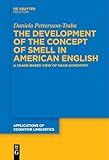The Development of the Concept of SMELL in American English : A Usage-Based View of Near-Synonymy / Daniela Pettersson-Traba.
Material type: TextSeries: Applications of Cognitive Linguistics [ACL] ; 51Publisher: Berlin ; Boston : De Gruyter Mouton, [2022]Copyright date: ©2022Description: 1 online resource (XVIII, 270 p.)Content type:
TextSeries: Applications of Cognitive Linguistics [ACL] ; 51Publisher: Berlin ; Boston : De Gruyter Mouton, [2022]Copyright date: ©2022Description: 1 online resource (XVIII, 270 p.)Content type: - 9783110792201
- 9783110792362
- 9783110792294
- 427.973
- online - DeGruyter
- Issued also in print.
| Item type | Current library | Call number | URL | Status | Notes | Barcode | |
|---|---|---|---|---|---|---|---|
 eBook
eBook
|
Biblioteca "Angelicum" Pont. Univ. S.Tommaso d'Aquino Nuvola online | online - DeGruyter (Browse shelf(Opens below)) | Online access | Not for loan (Accesso limitato) | Accesso per gli utenti autorizzati / Access for authorized users | (dgr)9783110792294 |
Browsing Biblioteca "Angelicum" Pont. Univ. S.Tommaso d'Aquino shelves, Shelving location: Nuvola online Close shelf browser (Hides shelf browser)

|

|

|

|

|

|

|
||
| online - DeGruyter The Orators and Their Treatment of the Recent Past / | online - DeGruyter Later Greek Epic and the Latin Literary Tradition : Further Explorations / | online - DeGruyter Documentality : New Approaches to Written Documents in Imperial Life and Literature / | online - DeGruyter The Development of the Concept of SMELL in American English : A Usage-Based View of Near-Synonymy / | online - DeGruyter Dynamiken historischer Schreibszenen : Diachrone Perspektiven vom Spätmittelalter bis zur klassischen Moderne / | online - DeGruyter Curiositas / | online - DeGruyter Bundestheologie bei Hosea? : Eine Spurensuche / |
Frontmatter -- Acknowledgements -- Contents -- List of figures -- List of tables -- List of abbreviations -- 1 Introduction -- 2 Synonymy -- 3 The concept pleasant smelling -- 4 Semasiological and onomasiological analyses of the synonym set -- 5 In-depth onomasiological analysis of the synonym set: A multivariate approach -- 6 Idiosyncratic collocational preferences of the near-synonyms -- 7 The concept pleasant smelling: A victim of societal change? -- 8 Concluding remarks and suggestions for future research -- List of references and sources -- Appendix -- Index
restricted access online access with authorization star
http://purl.org/coar/access_right/c_16ec
The last decades have witnessed a renewed interest in near-synonymy. In particular, recent distributional corpus-based approaches used for semantic analysis have successfully uncovered subtle distinctions in meaning between near-synonyms. However, most studies have dealt with the semantic structure of sets of near-synonyms from a synchronic perspective, while their diachronic evolution generally has been neglected. Against this backdrop, the aim of this book is to examine five adjectival near-synonyms in the history of American English from the understudied semantic domain of SMELL: fragrant, perfumed, scented, sweet-scented, and sweet-smelling. Their distribution is analyzed across a wide range of contexts, including semantic, morphosyntactic, and stylistic ones, since distributional patterns of this type serve as a proxy for semantic (dis)similarity. The data is submitted to various univariate and multivariate statistical techniques, making it possible to uncover fine-grained (dis)similarities among the near-synonyms, as well as possible changes in their prototypical structures. The book sheds valuable light on the diachronic development of lexical near-synonyms, a dimension that has up to now been relatively disregarded.
Issued also in print.
Mode of access: Internet via World Wide Web.
In English.
Description based on online resource; title from PDF title page (publisher's Web site, viewed 25. Jun 2024)


